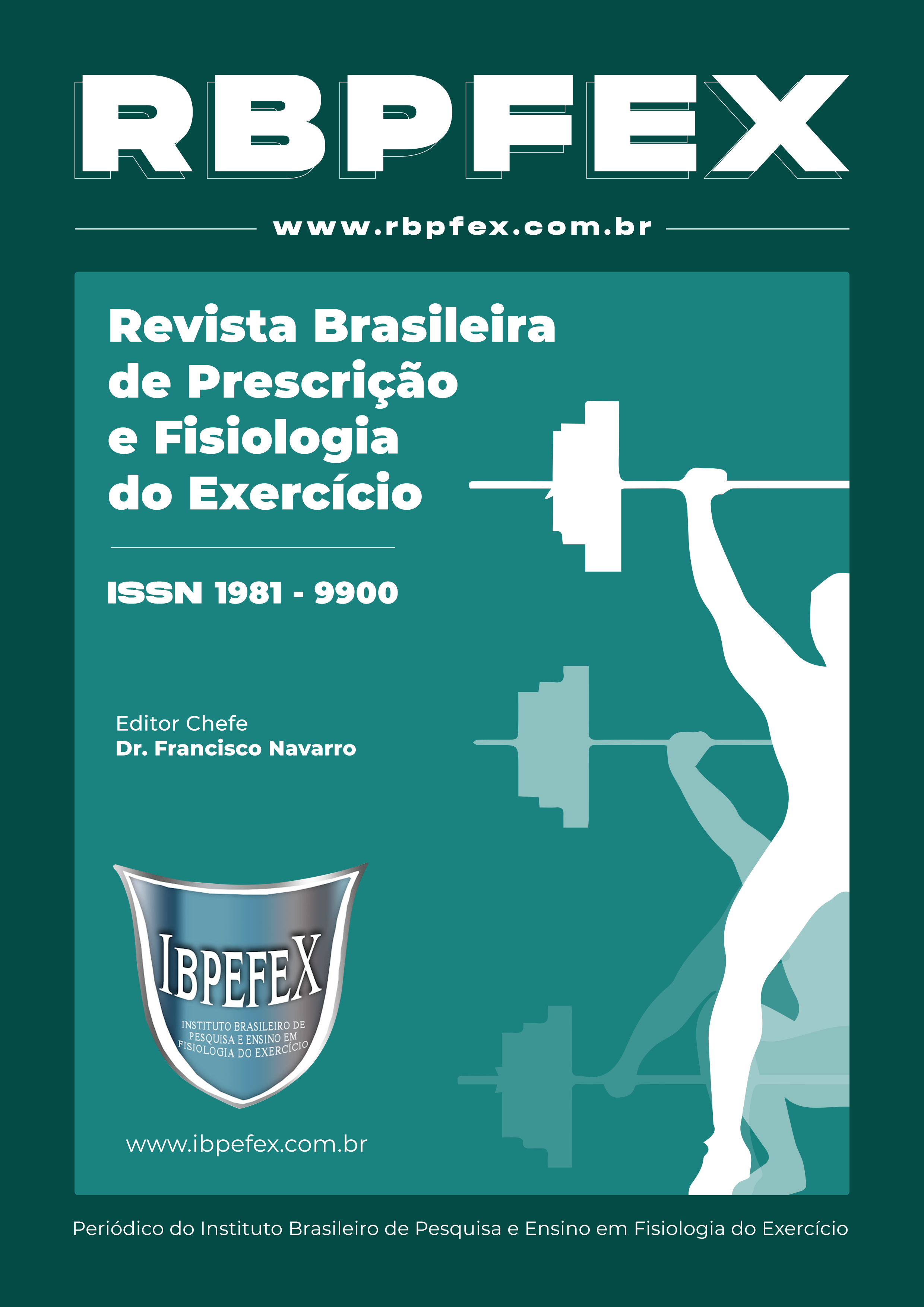Systematic review and meta-analysis about the effects of endurance training and whey protein supplementation on gene expression of MTOR, MURF-1, MAFBX
Abstract
Aim: Systematic review and meta-analysis about the effects of endurance training and Whey Protein supplementation on the gene expression of MTOR, MURF-1, MAFBX. Materials and methods: To this systematic review was used the concepts of systematic review and meta-analysis proposed by Thomas, Nelson, Silverman (2012), and Berwanger et al., (2007), and the search followed procedures proposed by Navarro and Navarro (2012), and for the criteria of evaluation of the technical and scientific quality of the texts was used the scale proposed by Galna et al., (2009). Results and discursion: From 724 eligible studies, the sample was 4 original articles where we inferred that the models of endurance training adopted in the experiments, are, the following: Jump in liquid environment, motorized treadmill, and, in squatting apparatus for electric stimulation in the base and that in terms of experimental study in relation to the dose of the supplement, the prescribed was recommended by manuals; and about the gene expression of MTOR, MURF-1, MAFBX, although had been verified it does not occurred due the endurance training and the Whey Protein supplementation and, therefore, absent. Conclusion: In terms of experimentation, it’s not found studies enough to compose the adequate procedure for a meta-analysis, even after a systematic review about the effects of endurance training and Whey Protein supplementation on the gene expression of MTOR, protein synthesis and the gene expression of MURF-1, MAFBx of protein degradation in wistar rats.
References
-Aparício, V.A.; Nebot, E.; Porres, J.M.; Ortega, F.B.; Heredia, J.M.; López-Jurado, P.A. Effects of high-whey-protein intake and resistance training on renal, bone and metabolic parameters in rats. British Journal of Nutrition. Vol. 105. Núm. 6. p. 836-845. 2011.
-Berwanger, O.; Suzumura, E.A.; Buehler, A.M.; Oliveira, J.B. Como Avaliar Criticamente Revisões Sistemáticas e Metanálises?. Revista Brasileira de Terapia Intensiva. Vol. 19. Núm. 4. p. 475-480. 2007.
-Bondine, S.C.; Stitt, S.T.; Gonzalez, M.; Kline, W.M.; Stover, G.M.; Bauerlein, R. AKT/MTOR Pathway is a Crucial Regulator of skeletal muscle hypertrophy and can prevent muscle atrophy in vivo. Nature Cell Biology. Vol. 3. Núm. 11. p. 1014-1019. 2001.
-Drummond, M.J.; et al. Skeletal muscle protein anabolic response to resistance exercise and essential amino acids is delayed with aging. Journal of Applied Physiology. Vol. 104. Núm. 5. p. 1452-1461. 2008.
-Galna, B.; Peters, A.; Murphy, A.; Morris, M. Obstacle crossing deficits in older adults: as ystematic review. Gait and Posture. Vol. 30. Núm. 3. p. 270-275. 2009.
-Gordon, B.S.; Kelleher, A.R.; Kimball, S.R. Regulation of muscle protein synthesis and the effects of catabolic states. The International Journal of Biochemistry & Cell Biology. Vol. 45. Núm. 10. p. 2147-2157. 2013.
-Guertin, D.A.; Sabatini, D.M. Defining the Role of MTOR in Cancer. Cancer Cell. Vol. 12. Núm. 1. p. 9-22. 2007.
-Haraguchi, F.K.; Silva, M.E.; Neves, L.X.; Santos, R.C.; Pedrosa, M.L. Whey proteins precludes lipid andprotein oxidation and improves body weigth gain in resistance-treined rats. European Journal of Nutrition. Vol. 50. Núm. 5. p.331-339. 2010.
-Haraguchi, F.K.; Magalhães, C.L.B.; Neves, L.X.; Santos, R.C.; Pedrosa, M.L.; Silva, M.E. Whey protein modifies genes expression related to protein metabolism affecting muscle weigth in resistance-exercised rats. Nutrition. Vol. 30. p. 876-871. 2014.
-Institute of Medicine (IOM). Dietary Reference Intakes: The Essential Guide to Nutrient Requirements. Washington, DC. The National Academies Press. 2005.
-Lancha Junior, A.R.; Campos-Ferraz, P.L.; Rogeri, P.S. Suplementação Nutricional no Esporte. Rio de Janeiro. Guanabara Koogan. 2009. Capítulo 8. p.135-166.
-Laplante, M.; Sabatini, D.M. MTOR signaling at a glance. Journal of Cell Science. Vol. 122. Núm. 20. p. 3589-3594. 2009.
-Laplante, M.; Sabatini, D.M. Regulation of mTORC1 and its impact on gene expression at a glance. Journal of Cell Science. Vol. 126. Núm. 8. p.1713-1719. 2013.
-Navarro, D.N.; Navarro, A.C. Quantificação e qualificação de estudos científicos sobre o ensino de química-eletroquímica. 12º Congresso Nacional de Iniciação Científica. 2012.
-Nunes, R.; Silva, P.; Alves, J.; Stefani, J.; Petry, M.; Rhoden, C. Applied Physiology Nutrition and Metabolism. Vol. 38. Núm. 11. p. 1166-1169. 2013.
-Phillips, S.M. Physiologic and moleculares bases of muscle hypertrophy and atrophy: impact of resistance exercise on human skeletal muscle (protein and exercise dose effects). Applied Physiology, Nutrition, and Metabolism. Vol. 34. Núm. 3. p.403-410. 2009.
-Rom, O.; Reznick, A.Z. The role of E3 ubiquitin-ligases MURF-1 and MAFBX in loss of skeletal muscle mass. Free Radical Biology and Medicine. Vol. 98. p. 218-230. 2016.
-Thomas, J.R.; Nelson, J.K.; Silverman, S.K. Métodos de Pesquisa em Atividade Física. 6nd ed. Artmed. 2012.
Copyright (c) 2023 Raphael Furtado Marques, Marcos Roberto Campos de Macêdo, Alanna Joselle Santiago Silva, Carlos Eduardo Neves Amorim, Antonio Coppi Navarro, Francisco Navarro

This work is licensed under a Creative Commons Attribution-NonCommercial 4.0 International License.
Authors who publish in this journal agree to the following terms:
- Authors retain the copyright and grant the journal the right of first publication, with work simultaneously licensed under the Creative Commons Attribution License BY-NC which allows the sharing of the work with acknowledgment of the authorship of the work and initial publication in this journal.
- Authors are authorized to enter into additional contracts separately for non-exclusive distribution of the version of the work published in this journal (eg, publishing in institutional repository or book chapter), with acknowledgment of authorship and initial publication in this journal.
- Authors are allowed and encouraged to post and distribute their work online (eg, in institutional repositories or on their personal page) at any point before or during the editorial process, as this can bring about productive change as well as increase impact and impact. citation of published work (See The Effect of Free Access).






